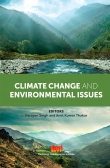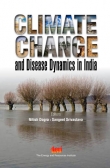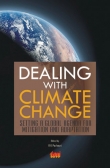Catalogue of Indian Emission Inventory Reports
- Size: 210mm x 290mm
- Pages: 110
- PDF Size: 4.38 MB
Book Details
A detailed air emission inventory (EI) with a comprehensive list of pollutants within a a pre-defended geographical area is beneficial for developing clean air action plans. It can also be used to test the effectiveness of pilot interventions towards air quality abatement. Emission inventories have been prepared for several Indian cities and states, however several of these EI reports have not been given due attention. This report presents a database of all publicly available EI reports and several previously un-referred studies for India to help policymakers and scientists prepare reckoner of all the work done in the area.
EI studies have been tabulated as per the source contribution (total emissions, transport, residential, industrial, power plants, agriculture, waste and others) along with details such as geography, grid size, emission factors used, and type of data collected (primary surveys vs secondary literature). Each sector list also consists of the pollutants studied and highlighted those reports that have adhered closely to the existing CPCB guidelines.
During the course of collating all EI reports, it was found that several researchers continue to rely solely on secondary data sets and use only foreign emission factors, even when Indian emission factors are available. Such inconsistencies in the existing body of literature show the need for developing and implementing systematic approaches towards data collection and reporting. They will ensure that the EI reports are accurate and enable better source apportionment studies. There have been a few reports at the pan-India level studies as well. However, there are considerable lacunae on the geographical spread of emission inventory (EI) reports. Predictably, Delhi NCR and states in the Indo-Gangetic Plain have several EI reports. However, EI reports are sparse in the southern and north-eastern states. We hope this will change as now all 132 non-attainment cities under the National Clean Air Programme (NCAP) are developing their emission inventories and source apportionment studies.
As per various operating sections of the Air Act 1981, air pollution monitoring, calculation of pollution load, preparation of emission inventory, preparation of action plan for air pollution control should be done as per SOP issued by CPCB from time to time. Therefore, emission inventory prepared by agencies and experts using other methodology may not be tenable per Air Act 1981. In its order for Critically Polluted Areas and Non-Attainment Cities, the National Green Tribunal mentioned that methodologies recommended by CPCB should be followed for such studies.
In recent years the nature of pollution sources has evolved significantly. Identifying them is crucial for prioritizing actions to mitigate air pollution. Further, several sources are not considered big emitters. For instance, emissions from restaurants and bakeries are significantly less than emission load from the transport sector. However, cumulatively these sources (including but not limited to construction and demolition waste, paved road dust, crematoria, bakeries and restaurants, diesel gen-sets) add up to a significant number. These sources are usually only accounted for total emission inventory studies, but we now need a more substantial push to develop individual EI reports for such less studied sectors.
About 200 EI reports have been collated and made available with hyperlinks for researchers and policymakers to use. They have also been sectorally classified for ease. Cities are now implementing clean air action plans, and NCAP funding is tied to performance. Therefore, periodically revised emission inventories could help check the efficacy of actions in each sector. Finally, regional emission inventories now need to be prioritised as now the airshed approach has gained prominence in the battle against air pollution.
Key Findings:
-- An easy to use ready reckoner of air pollution emission inventory studies for India was created. These reports were catalogued as per sectors; Total emissions, Transport emissions, Industrial and Power Plant emissions, Residential emissions and Emissions from Agriculture, Waste and other misclenous sectors.
-- It was found that only some followed the CPCB guidelines closely, of using indigenous emission factors and primary data for creating emission inventories.
-- Geographically, most of the studies were concentrated in the Indo-Gangetic Plain, with a high focus on Delhi and National Capital Region. There were few reports from Odisha, Goa, North-eastern states, Jammu and Kashmir, Kerala and Madhya Pradesh.
-- While sectors like transport have many reports, there are some pollution sources that need to be explored further and regional and national scale EI reports need to be developed. These include brick kilns, road dust, diesel generator sets, wood fired crematoriums, restaurants, bakeries, etc.
-- Emission factors for fugitive emissions from various types of mining activities, road dust (unpaved and paved), raw material handling, biomass burning in landfill sites and other open areas, wood-fired crematoriums, use of coal and biomass in domestic stoves, use of LPG and PNG in gas stoves, etc. are not developed in India. Therefore, relying on the emission factors developed by USEPA might lead to inaccuracies.
-- Inventories need to be developed for toxics like VOCs and heavy metals like mercury. Doing so will enable development of standards for these pollutants
-- Multiple emission inventories for the same city and region leads to uncertainties. Rather, a framework for EI development should be followed. EIs should be periodically updated every few years to test the efficacy of interventions. For instance, in the transport sector, EI for current year, could help gain insights on the effects of introduction on BS VI mass emission standards on road transport emissions. In the residential sector, introduction of LPG in rural households would have led to reduction in emissions and this should reflect in the latest EI report
-- Robust EI reports form the mainstay of source apportionment cities and development of mitigation strategies. Therefore, oversight on EI reports is required, especially now that all 132 non-attainment cities have been mandated to carry out source apportionment studies. Further, regional EI needs to be carried out for areas within the same airshed, in order to strategize mitigation actions with an airshed approach
You may also like...
-
 50 FAQs on Climate Change, Second Edition (know all about climate change and do your bit to limit it)
Regular Price 125.00
Special Price 112.00
50 FAQs on Climate Change, Second Edition (know all about climate change and do your bit to limit it)
Regular Price 125.00
Special Price 112.00
-
 Climate Change and Environmental Issues
Regular Price 795.00
Special Price 715.00
Climate Change and Environmental Issues
Regular Price 795.00
Special Price 715.00
-
 Climate Change and Disease Dynamics in India
Regular Price 995.00
Special Price 895.00
Climate Change and Disease Dynamics in India
Regular Price 995.00
Special Price 895.00
-
 Dealing with Climate Change: setting a global agenda for mitigation and adaptation
Regular Price 695.00
Special Price 625.00
Dealing with Climate Change: setting a global agenda for mitigation and adaptation
Regular Price 695.00
Special Price 625.00

